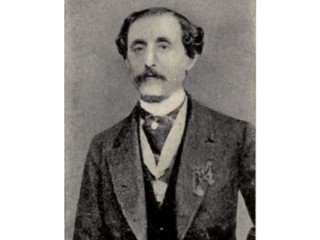
Louis Moreau Gottschalk biography
Date of birth : 1829-05-08
Date of death : 1869-12-18
Birthplace : New Orleans, Louisiana, United States
Nationality : American
Category : Famous Figures
Last modified : 2011-10-17
Credited as : opera composer, romantic pianist, Bamboula
Louis Moreau Gottschalk, probably the most important American composer of the 19th century, infused European romanticism with indigenous North and South American elements.
Louis Moreau Gottschalk was born on May 8, 1829, in New Orleans, the son of a Jewish Englishman and a Creole woman. He exhibited extraordinary talent at the age of 3. At 13, after experience as a church organist and a concert pianist, he went to Paris to study, absorbing the romantic ideas and attitudes of the time and acquiring an elegant, polished manner.
Gottschalk took Paris by storm when he made his 1845 concert debut. Frederic Chopin predicted a brilliant future for him, and Hector Berlioz spoke of his "exquisite grace … brilliant originality … charming simplicity … thundering energy."
When Gottschalk returned to America, P. T. Barnum offered him a contract for $20,000 yearly plus expenses; Gottschalk refused scornfully. Compared favorably to Beethoven in the reviews of his New York debut, he launched his American career.
But Gottschalk's world soon collapsed. His father died, and he was forced to assume a considerable debt and to support his mother and six brothers and sisters. The stress caused the quality of his compositions to deteriorate. He wrote shameless potboilers. His fresh, original impulses were eroded as he became more adept at composing vapid salon music. He gave concerts almost daily—80 concerts in New York alone within a 2-year period.
Then Gottschalk retreated for almost 6 years to a life of splendid dissipation in Cuba and the Caribbean islands. Yet there he wrote some of his best compositions.
Gottschalk resumed his hectic activity during the Civil War period. His concerts inspired phenomenal enthusiasm. Moreover, he organized mammoth festivals involving hundreds and even thousands of musicians, receiving thunderous ovations from the public. During his largest festival, in Rio de Janeiro in 1869, Gottschalk's Marche triomphale aroused tremendous enthusiasm. Exhausted by his feverish way of life and weakened by yellow fever, he died 2 weeks later.
Gottschalk's music infuses European structures with American folk and popular music as well as Latin American elements. He wrote two operas and several orchestral works. His piano works show his wide range, romantic sweep, rhythmic freshness, and varieties of mood and color.
Bamboula and Le Bananier, early works, contain infectious rhythms and Creole tunes. Souvenirs d'Andalousie and Manchega use Spanish color and rhythms. El cocoye and La gallina are musical essays on Cuban music. Suis-moi and O! Ma charmante, epargnez-moi! are forays into the music of the Antilles. L'Union and America utilize patriotic airs. Chant du soldat suggests the romantic sweep of Berlioz or Chopin. Impromptu and Danza are sparkling salon pieces. However, Gottschalk's best-known works, The Dying Poet and The Last Hope, are both considered potboilers.
In addition to his musical accomplishments, Gottschalk produced imaginative writings; his Notes of a Pianist (1881; repr. 1964) provides a fascinating chronicle of 19th-century American musical life. See also Vernon Loggins, Where the Word Ends: The Life of Louis Moreau Gottschalk (1958). There are illuminating chapters on him in Gilbert Chase, America's Music: From the Pilgrims to the Present (1955), and Harold C. Schonberg, The Great Pianists (1963).
















